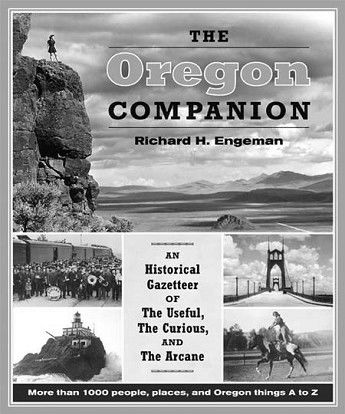Examining Oregon’s curious history
Published 8:06 am Sunday, December 20, 2009

- Examining Oregon's curious history
Engeman, Richard H. “The Oregon Companion: An Historical Gazetteer of the Useful, the Curious and the Arcane.” 2009 Timber Press. Paperback; 432 pages with 167 b&w photos. Retails for $27.95.
Did you know the corn dog was invented in 1941 by George and Versa Boyington, hot dog stand owners in the Oregon resort town of Rockaway Beach? Originally named the Pronto Pup, the hot dog on a stick with a built-in bun of cornmeal still is a favorite fair food throughout the United States. This and more than a thousand other tidbits of Oregon history can be found between the covers of “The Oregon Companion: An Historical Gazetteer of The Useful, The Curious and The Arcane,” published in 2009 by Timber Press just in time for Oregon’s 150th anniversary of statehood.
When I read a synopsis of The Oregon Companion, I was intrigued. Billed as “More than 1,000 people, places and Oregon things A to Z,” I just had to see what it was all about. And I was pleasantly surprised that, once I started leafing through the chapters, I just couldn’t put it down.
The book was meticulously researched and compiled by Richard Engeman, the former public historian of the Oregon Historical Society. The information was amassed over the course of three decades of research during his time at Reed College, the University of Oregon and the University of Washington, and through his work for the Oregon Historical Society, the Portland Landmarks Commission, the Oregon Museums Association and the Oregon Century Farm & Ranch Program. The result is a veritable who’s who, what’s what and where’s where of Oregon, illustrated with more than 150 historical black and white photos.
The book is organized alphabetically and thoroughly cross-referenced, so entries are easy to find and often lead to further exploration. While the entries are hardly comprehensive on an individual subject, each one gives an overview that invites further research, and literary references are included for many subjects. Cross-indexed terms in bold type lead the reader deeper into the book to explore the interconnections between entries.
Looking up Umatilla County leads to the Pendleton Round-Up, and then to publisher C.S. Jackson, who started his newspaper career with the East Oregonian and ended with the Oregon Journal. From there we head to the Columbia River Highway, which was developed with the backing of Jackson and other Portland-area civic leaders. This leads us to Sam Hill, the attorney and creator of Maryhill Museum, who was instrumental in developing the idea of a motorway through the Columbia River Gorge. There is no end of stories that will engage and surprise you.
While the majority of the book focuses on Oregon history, population trends through 2007 are included for incorporated Oregon cities. The compendium would make a valuable addition to reference collections, and as a coffee table or bedside book will entertain for a few minutes to a few hours. Engeman’s accessible writing style makes this book an engaging read for young and old alike.





